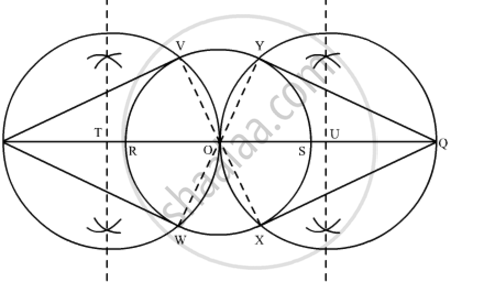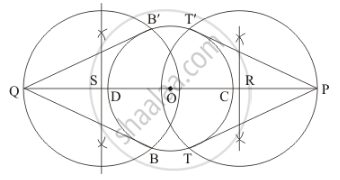Advertisements
Advertisements
Question
Draw a circle of radius 3 cm. Take two points P and Q on one of its extended diameter each at a distance of 7 cm from its centre. Draw tangents to the circle from these two points P and Q. Give the justification of the construction.
Solution 1
The tangent can be constructed on the given circle as follows.
Step 1
Taking any point O on the given plane as centre, draw a circle of 3 cm radius.
Step 2
Take one of its diameters, PQ, and extend it on both sides. Locate two points on this diameter such that OR = OS = 7 cm
Step 3
Bisect OR and OS. Let T and U be the mid-points of OR and OS respectively.
Step 4
Taking T and U as its centre and with TO and UO as radius, draw two circles. These two circles will intersect the circle at point V, W, X, Y respectively. Join RV, RW, SX, and SY. These are the required tangents.

Justification
The construction can be justified by proving that RV, RW, SY, and SX are the tangents to the circle (whose centre is O and radius is 3 cm). For this, join OV, OW, OX, and OY.

∠RVO is an angle in the semi-circle. We know that angle in a semi-circle is a right angle.
∴ ∠RVO = 90°
⇒ OV ⊥ RV
Since OV is the radius of the circle, RV has to be a tangent to the circle.
Similarly, it can be shown that RW, SX, and SY are the tangents of the circle.
Solution 2
Given that
Construct a circle of radius 3 cm, and let a point P and Q extended diameter each at distance of 7cm from its centre. Construct the pair of tangents to the circle from these two points P and Q.
We follow the following steps to construct the given

Step of construction
Step: I- First of all we draw a circle of radius = 3 cm.
Step: II- Make a line CD = diameter = 6 cm.
Step: III-Extend the line CD in such a way that point CP = DQ = 7 cm
Step: IV- CP at a distance of OP = 7 + 3 = 10 cm, and join OP draw a right bisector of OP, intersecting OP at R.
Step V:- Similarly, DQ at a distance of OQ = 7 + 3 = 10 cm, and join OQ draw a right bisector of OQ, intersecting OQ at S.
Step VI: Taking R and S as centre and radius OS = OR, draw a circle to intersect the given circle at T and T’
B and B ’respectively.
Step: VII- Joins PT and PT’ as well as QB and QB’ to obtain the require tangents.
Thus, PT and P'T' , QB and QB' are the required tangents.
APPEARS IN
RELATED QUESTIONS
Draw a right triangle ABC in which AB = 6 cm, BC = 8 cm and ∠B = 90°. Draw BD perpendicular from B on AC and draw a circle passing through the points B, C and D. Construct tangents from A to this circle.
Draw a line segment AB of length 7 cm. Taking A as centre, draw a circle of radius 3 cm and taking B as centre, draw another circle of radius 2 cm. Construct tangents to each circle from the centre of the other circle.Steps
Draw a circle of radius 4.5 cm. Draw two tangents to this circle so that the angle between the tangents is 60°.
Construct an equilateral triangle ABC with side 6 cm. Draw a circle circumscribing the triangle ABC.
Draw an inscribing circle of a regular hexagon of side 5.8 cm.
Draw a circle of radius 3.5 cm. Mark a point P outside the circle at a distance of 6 cm from the centre. Construct two tangents from P to the given circle. Measure and write down the length of one tangent.
Write the steps of construction for drawing a pair of tangents to a circle of radius 3 cm , which are inclined to each other at an angle of 60° .
Take a point O on the plane at the paper. With O as center draw a circle of radius 3 cm. Take a point P on this circle and draw a tangent at P.
Draw a circle of radius 3 cm. Construct a square about the circle.
Draw a circle of radius 4 cm. Take a point P outside the circle without using the center at the circle. Draw two tangents to the circle from point P.
